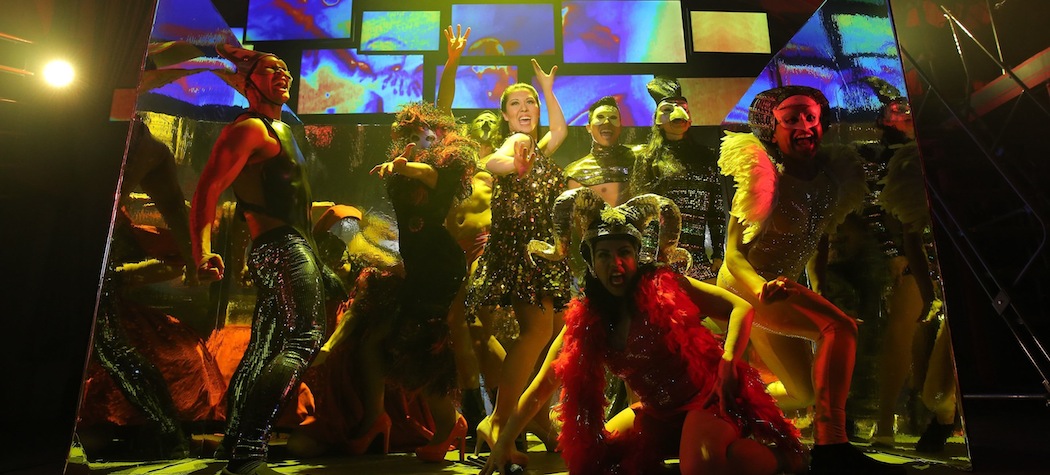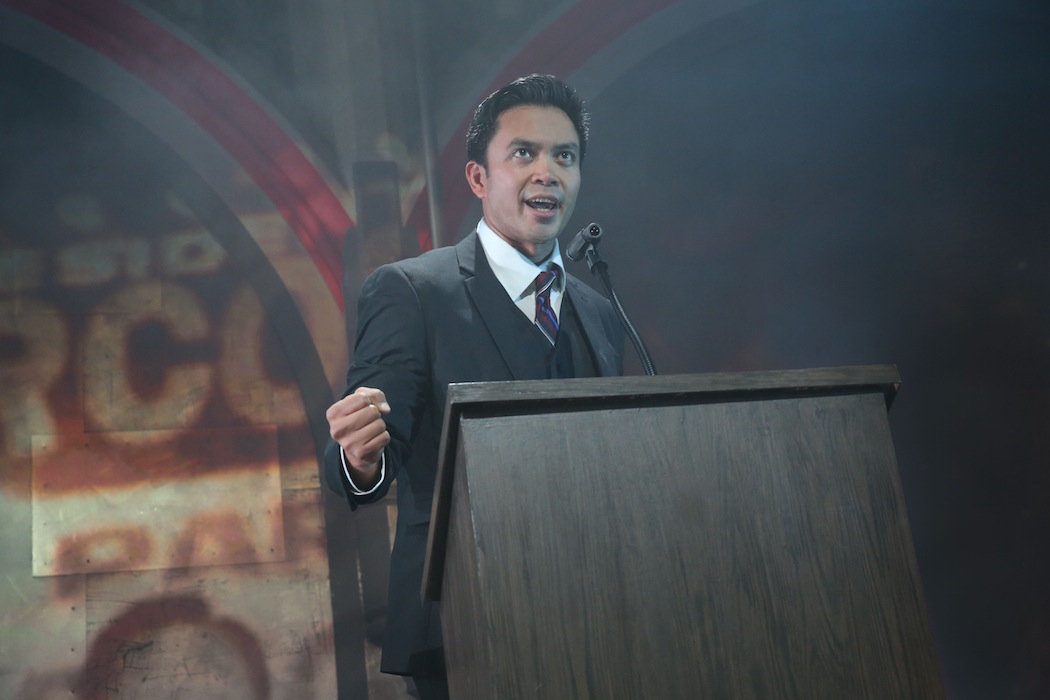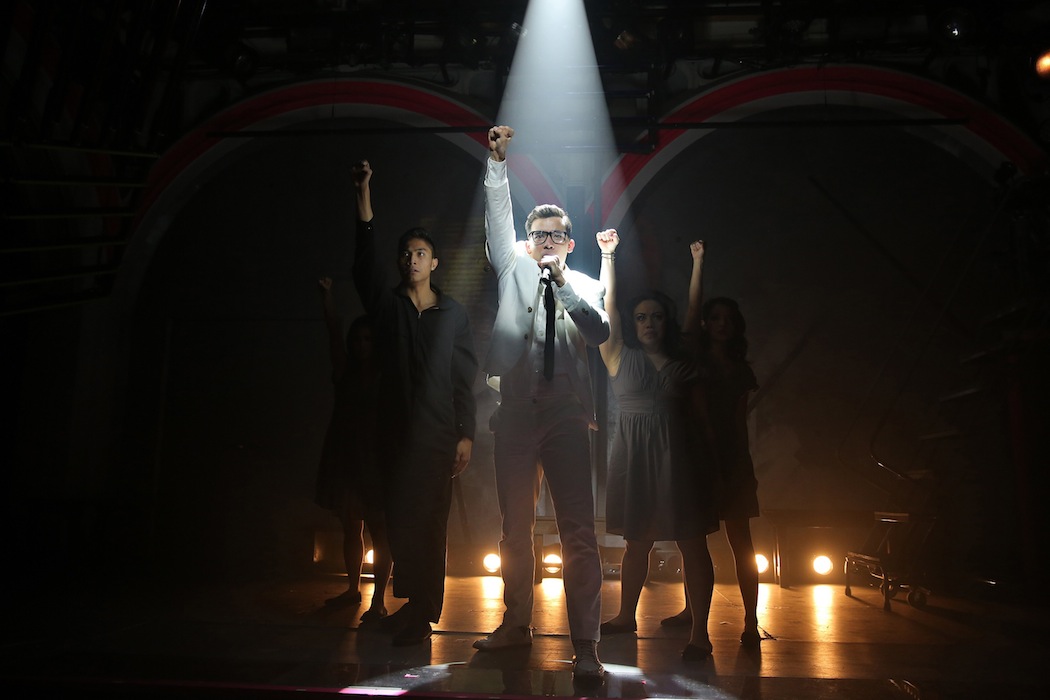Advertisement
'Here Lies Love' — David Byrne Makes Beautiful Music With Imelda Marcos

NEW YORK — Why should it be any surprise that a David Byrne “musical” should be a sensation? The guy not only knows his way around the rhythms of a rock song but is one of the great melodists of the post-Beatles universe. He also has the great good sense of surrounding himself with like-minded talent of the highest order, beginning with Talking Heads and extending to Brian Eno, choreographer Twyla Tharp and St. Vincent.
Now, in “Here Lies Love,” Byrne has joined forces with cowriter Fatboy Slim, Public Theater honcho Oskar Eustis, choreographer Annie-B Parson (“Man in a Case”) and director Alex Timbers (“Bloody Bloody Andrew Jackson”).
But this is a Byrne musical if it be a musical at all. It’s more a theatrical event, an adventure in immersive theater that stretches the boundaries of theater well beyond what’s been done at OBERON which, by the way, would be wise to import its own version of “Here Lies Love” as soon as possible. It would fit the Cambridge space even better than the Public.
As with “The Donkey Show,” you have the choice with “Here Lies Love” to sit apart from the action, which you shouldn’t do, unless you can’t stand for 80 or 90 minutes. Instead, be a 21st-century groundling, as the stage moves all around the black box space, where you get to witness the transformation of Ferdinand and Imelda Marcos from the John and Jackie of the Philippines to the Lord and Lady Macbeth of the island.
All to the accompaniment of the disco beat that Imelda loved and some of the prettier ballads that have been heard in a theater since its golden age. But for all the excellence of the music, it’s the vibe that makes the show such a standout.
Attendants in jumpsuits guide the audience around the floor to hot spots where dancers strut their stuff; Benigno “Ninoy” Aquino woos Imelda (he dumped her, according to Byrne, because she was too tall); Imelda turns to World War II hero Ferdinand; and, finally, we witness the fall of the Marcoses and the rise of the People Power Revolution.
Along the way I got to proudly shake hands with Imelda as she campaigned for Ferdinand. Proudly? Yes, I have to say that I always thought of her as a silly woman who, at best, is delusional and, at worst, a symbol of right-wing dictatorship.

Byrne, though his politics are with the rebels, subverts the narrative, beginning with banning her shoe collection from the proceedings. He also gives Imelda almost all the beautiful ballads, in which she “grows” from a poor naïf to loyal wife blinded by the trappings of power.
Start with “Here Lies Love,” Imelda’s cri de couer, which makes more sense in the staged version than on the original song cycle, in which Byrne and Fatboy Slim had Florence Welch (of Florence and the Machine) sing of Imelda’s hopes and strivings.
In the show, however, it’s obvious that Imelda — at least in the persona fashioned by Byrne — really believed in the transformative power of love, whether for Ferdinand or for Filipinos. The song refers to herself as the personification of love:
“Is it a sin to love too much?
Is it a sin to care?
I do it all for you — how can it be unfair?
I know that when my number’s up
When I am called by God above
Don’t have my name inscribed into the stone … Just say:
Here lies love, Here lies love, here lies love”
Byrne and company start with that construct and seduce us into seeing the whys and hows of hero worship, first of Ferdinand and then of Ninoy. Hopefully there’s no video of me chanting and dancing (or trying to) with Aquino’s call to turn on the regime:

“I’ma rise up
I’ma rise up.”
But that’s what makes “Here Lies Love” simultaneously fun and powerful. It’s both intellectually and emotionally involving — reminding us that the Marcoses weren’t always the stick figures that they turned into while being equally adamant that the forces of progress were with the nonviolent revolutionaries.

Ruthie Ann Miles has won raves as Imelda, but I saw her understudy, Jaygee Macapugay, who isn’t at all Imelda’s body type. It hardly mattered, in fact it might even have helped as the sweetness of Macapugay’s singing and stage presence wins Imelda something of a do-over.
The show is wonderfully cast and the stars, the ensemble, the design team and those aforementioned collaborators — Parson and Timbers — don’t leave anything to be desired.
Byrne has an interesting section in the liner notes to the Nonesuch soundtrack about the difference between pop songs like his, which are meant to convey an emotional moment, and musical theater songs that convey change in the character(s). I’m not sure the difference is as great as he makes it out to be but there’s no doubt that “Here Lies Love” is fresh theatrical air. Whether it’s a musical or some other theatrical event, it’s the best music in theatrical form I’ve seen since “Caroline, or Change.”
That great musical about a young Jewish boy and a black maid, was written by Tony Kushner and Jeanine Tesori. Tesori, unlike most of today’s musical composers, only writes the music to scores, leaving the lyrics to others. She wrote the music for another recent Public Theater show, “Fun Home,” and is currently represented on Broadway by the Roundabout Theatre Company revival of 1997's “Violet” at Amerian Airlines Theatre.
I thought it would be instructive to go to the show after a 5 p.m. “Here Lies Love” performance, but it wasn’t the way to see it. For one thing I missed the opening number, but the story about a woman who grows to accept her disfigurement seemed insignificant after “HLL.” And I much preferred the SpeakEasy staging of 2000 with the bright-eyed Bridget Beirne to the proscenium presentation here with a disappointingly dower Sutton Foster.
I don’t know that “Here Lies Love” replaces the traditional musical, but on this particular night, it was certainly in a class by itself.


